

Exploring our past to sort out myth from reality
Share this Page on
Facebook or Twitter

These are the voyages of the TimeShip Anachron.
Our Mission: To boldly explore the past, dispelling
mythinformation and mythconceptions
of American History along the way.
 Visit us on Facebook
Visit us on Facebook
Meet MythAmerica Series

Pt 1 Pt 2 Pt 3 Pt 4 Pt 5 Pt 6 Pt 7 Pt 8 Pt 9 Pt 10 Pt 11
The Not-So-Gay Nineties, Part 1
MythVictorian America
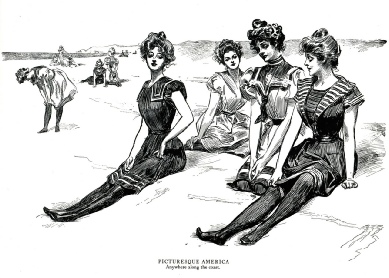
I recently asked my 40-
She was, however, just a bit familiar with some of the stereotypical visuals of that period, because she was familiar with the term “Victorian Era,” which does overlap the 1890s. I showed her the picture above and asked if she had heard of “Gibson Girls” like these from that time period. Illustrator Charles Dana Gibson created this “look” for the supposedly ideal young woman of the turn of the last century. His artwork, and that of many imitators, was featured on the covers (and also used for ads and story illustrations in) magazines and newspapers and elsewhere.
Ramona had indeed heard of Gibson Girls, but not from a “history book.” She knew of it because it was used in a 1987 Anne of Green Gables TV movie (Anne of Avonlea), which was set in that time period. One character exclaimed to Anne, who had her hair piled on her head in the way you see on the young bathing beauty girls above, that she looked “just like a Gibson Girl.”

After thinking it over, I realized that indeed, the decade of the 1890s had not been featured in any “pop culture fads” in recent times, in the way that the 1920s have with the recent Great Gatsby movie. All sorts of websites now are dedicated to how to get the Roaring Twenties “Gatsby look” in fashions for both men and women.
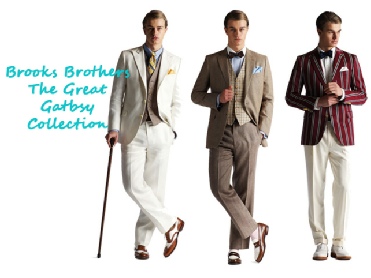

And the Happy Days of the 1950s have had numerous re-
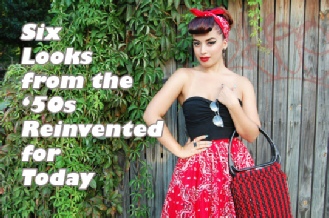
But the 1890s have not had that kind of popularity for a long, long time.
And thus the average person my daughter’s age or younger has had no pop culture references around which to form even a pseudo-
This was not true in the 1950s when I was growing up. I guess you’d say back then that the Gay 90s were to us what the Fabulous Fifties became to later generations. Nowadays if you want your small restaurant to look “quaint” and “retro” you make it look like a Fifties diner.
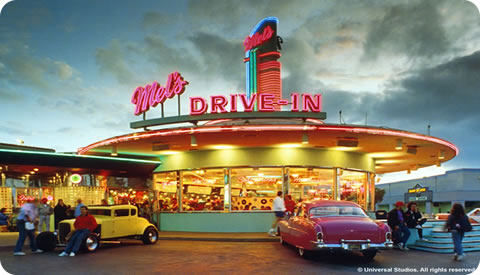
In the 1950s if you wanted your small lunch room to look quaint, you’d make it look like a Gay Nineties Ice Cream Parlor.
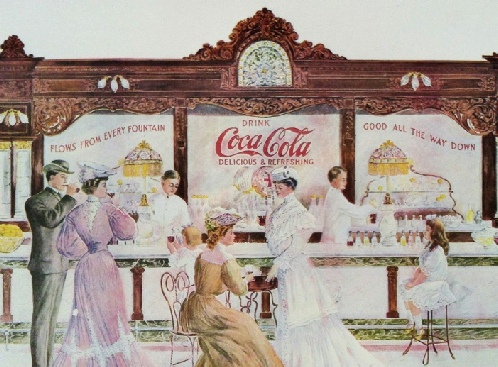
And if you have music in your pseudo-
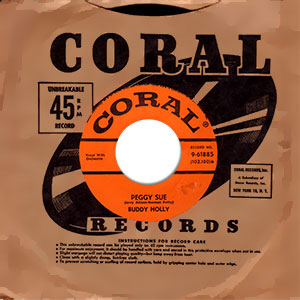
Back in the Fifties your pseudo-
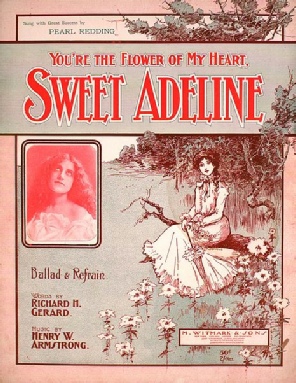
Yes, the 1890s—or at least a mythological reincarnation of the era—was a centerpiece of a lot of nostalgia in my youth. I found out why recently.
The term Gay Nineties became widely used during the Great Depression, the worldwide business slump of the 1930s. At the time, the people longed for a comfortable past and chose to remember only the prosperous years and the heroic events of the 1890s. Among the pleasant memories of the Gay Nineties were the charming gas lights and lively vaudeville shows. There were also the 5 cent motion picture theaters called Nickelodeons. There was the memory of Lt. Col. Theodore Roosevelt leading the fearless Rough Rider Regiment against the Spaniards in Cuba three years before he became the nation's 26th President. And there was the memory of the marvelous new Ferris wheel of the World's Columbian Exposition in Chicago in 1893. [Source]
Folks in the ‘30s, most of whom were too young to actually remember what it was really like to live through the period of the 1890s, created a mythology about the era to counter their own gloom. As another author put it:
…the Gay Nineties were a romantic notion of the American 1890's and 1900's most prevalent in the 1930's through 1960's. Understandably so, given the complications of the Dirty Thirties, World War II and dawning Cold War. [Source]
Yes, even during what was later viewed (through a distorted lens) as the Fabulous Fifties, conditions were so bleak—what with H-
Walt Disney played on this fact enthusiastically when he opened Disneyland in 1955. The whole D-
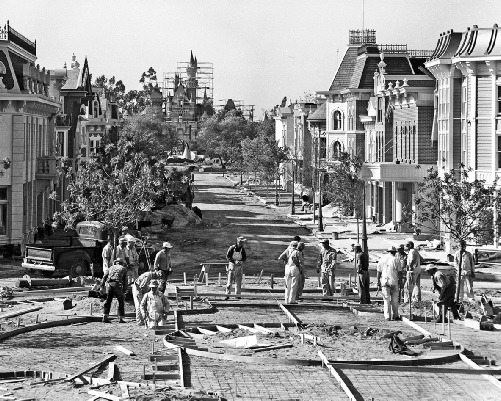
By the time the Disney Imagineers created a replica of this replica for the Walt Disney World Magic Kingdom in Florida, they had the nostalgia-
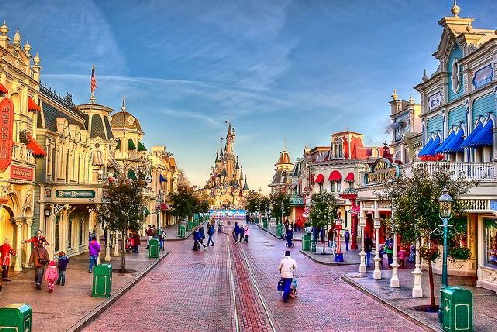
When I first visited Magic Kingdom in 1975, I was convinced that I was being immersed in a tiny taste of what it would have been like to live in the Gay 90s! There was the Ice Cream Parlor and the Gibson Girl.
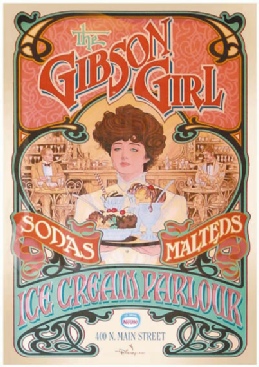
There were the barbershop quartet guys.
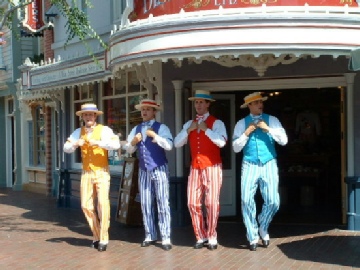
There was the ragtime piano player.
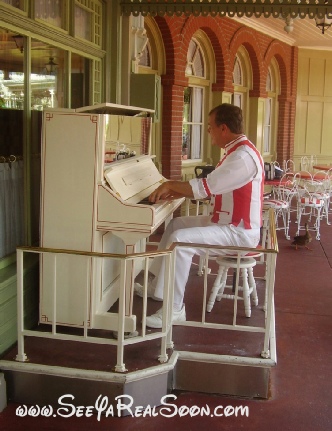
And there were all the beautiful turn of the century-
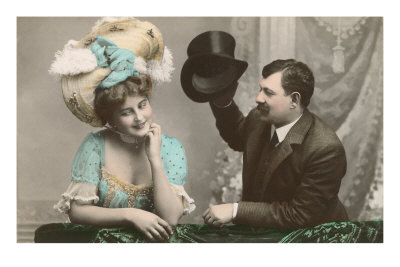
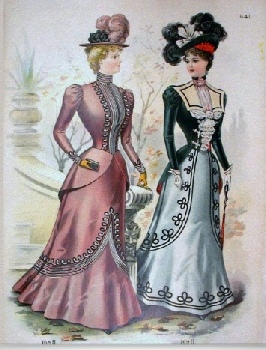
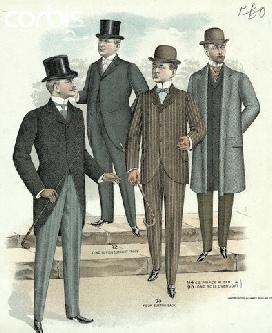
It was quite some time later, when researching Walt Disney’s life, that I found that Main Street, USA was inspired by his fond memories of the hometown of his youth, Marceline, Missouri. His recollections of what it was like to walk the main street there no doubt mellowed with the many years that had passed since he’d lived there. Walt was born in 1901, and the family moved to Marceline in 1906. They were there five years, and moved away in 1911. So Walt had five years to imprint in his young mind the sights of Marceline. So…just what WAS it like in Magical Marceline in 1909 while Walt lived there? Here ya go …
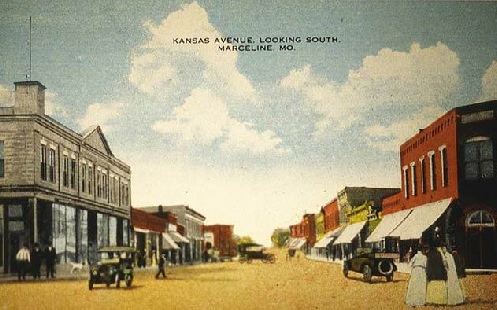
Dirty, dusty street, dogs (and no doubt dog doodoo), drab buildings, and the din of very early Model T’s likely sputtering and backfiring. Methinks ol’ Walt took more than a bit of “poetic license” with his spotless, pristine, splendiferous recreation!
Not that this doesn’t make for a nice vacation theme park experience. But the vast majority of the population has had little other “input” in the past fifty years regarding what life was really like around the turn of the last century. So I would suggest that it’s one more factor in why the average American in 2013 is pathetically ignorant of the “real” American Experience of that time period.
For quite frankly, life for the average American of that era was about as far from full of gaiety as it could possibly get.
THE GOOD OLD DAYS – were they really good? On the surface they appear to be so – especially the period to which this term is most often applied, the years from the end of the Civil War to the early 1900’s. This period of history has receded into a benevolent haze, leaving us with the image of an ebullient, carefree America, the fun and charm of the Gilded Age, the Gay 90s.
But this gaiety was only a brittle veneer that covered widespread turmoil and suffering. The good old days were good for [only] the privileged few. For the farmer, the laborer, the average breadwinner, life was an unremitting hardship. This segment of the populace was exploited or lived in the shadow of total neglect. And youth had no voice. These are the people, the mass of Americans, whose adversities this book attempts to chronicle.
“This book” is a reference to a classic volume titled The Good Old Days—They Were Terrible!
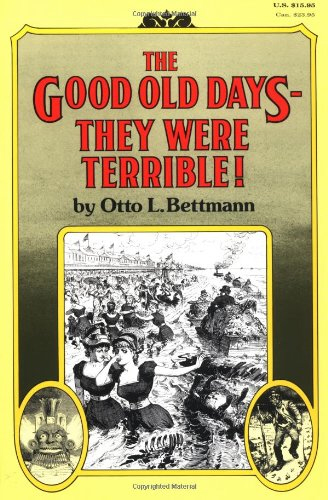
The author is no politically-
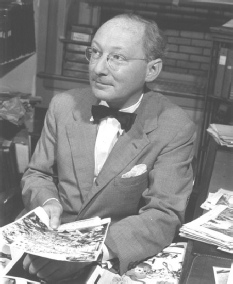
In 1935, Otto Bettmann escaped from Nazi Germany, traveling with two steamer trunks filled with around 15,000 photos, drawings, engravings, and art reproductions, his own personal collection. The next year, he formalized them as the “Bettmann Archives,” which he housed in his own apartment in New York City until 1960—adding to the collection as time went on.
“Adding to” is an understatement.
The Bettmann Archive is a collection of 19 million photographs and images, some going back to the United States Civil War and including some of the best known U.S. historic images. The Archive also includes many images from Europe and elsewhere. It was founded in 1936 by Otto Bettmann (1903–1998), a German curator who emigrated to the United States in 1935. In 1960, Bettmann moved it from his apartment in New York City to the Tischman building on West 57th Street, New York City. In 1981, Bettmann sold the archive to the Kraus Thomson Organization. In 1995, the archive was sold to Corbis, a digital stock photography company founded by Bill Gates.
…In 2002, to preserve the photos and negatives, Corbis moved the archive from Manhattan to the Iron Mountain National Underground Storage Facility, a former limestone quarry located 220 feet (67 m) below ground in western Pennsylvania. The temperature of the storage room is gradually being lowered to -
The Good Old Days book was written by Bettmann in 1974, when he was still very active with the Archive, and writing books on specific topics illustrated by photos from the collection such as A Pictorial History of Medicine. I believe the evidence shows him to have been a balanced, sensible commentator regarding American History, writing without any personal and/or political agenda. The comments quoted above are from the Introduction to the Good Old Days book. Here are further comments from that Intro.
Such an endeavor may come as a surprise to those who are familiar with my work. The files of the Bettman Archive bulge with graphics of what we call the golden past. Many do, indeed, exude an aura of charm and well-
I have always felt that our times have overrated and unduly overplayed the fun aspects of the past. What we have forgotten are the hunger of the unemployed, crime, corruption, the despair of the aged, the insane and the crippled. The world now gone was in no way spared the problems we consider horrendously our own, such as pollution, addiction, urban blight or educational turmoil. In most of our nostalgia books, such crises are ignored and the period’s dirty business is swept under the carpet of oblivion. What emerges is a glowing picture of the past, of blue-
If we compare this purported Arcadia with our own days we cannot but feel a jarring discontent, a sense of despair that fate has dropped us into the worst of all possible worlds and the future, once the resort of hopeful dreams, is envisioned as an abyss filled with apocalyptic nightmares.
My post at the “the picture window of history” has given me a more optimistic if less fashionable vista. I have concluded that we have to revise the idealized picture of the past and turn the spotlight on its grimmer aspects. This more realistic approach will show us Gay Nineties man (man in the street, not in the boardroom), as one to be pitied rather than envied. He could but dream of the Utopian miracles that have become part of our everyday life. Compared with him we are lucky – even if dire premonitions darken our days and we find much to bemoan in our society.
Proceeding from such convictions, this may be called a missionary book, a modest personal attempt to redeem our times from the aspersions cast upon them by nostalgic comparisons. …
Even if we cast but a cursory glance at the not so good old days and bring them into alignment with our own, we will find much to be grateful for. We are going forward, if but slowly. This fact should move us to view the future in less cataclysmic terms…
I have come independently to the exact same conclusions as Otto Bettmann through my own historical research in recent times. I am tired of hearing and reading the never-
And when all American citizens supposedly had so much more “personal liberty” than now…the golden years when The American Dream was allegedly within reach for all. I know many folks who think this grand and glorious time was a century ago, and they yearn to return to it as if it were, indeed, Utopia. (And who thus are consigning their own children and grandchildren, through their words and the example they are setting, to feelings of angst, anger, and despair about the problems of the present, and hopelessness about the future.)
All right then, let’s return to those Good Old Days…for a visit. And see if you’d REALLY want to “stay there.”
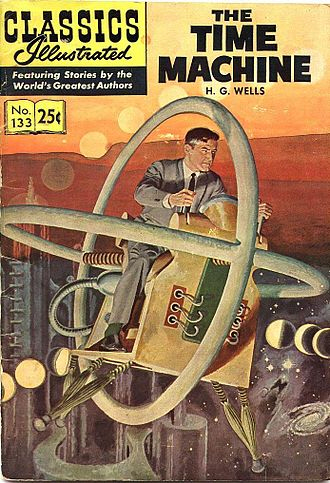
Join me as we enter the Time Machine and crank ‘er back to the actual heyday of H.G. Wells (who published his classic book The Time Machine in 1895!)
~~~~~